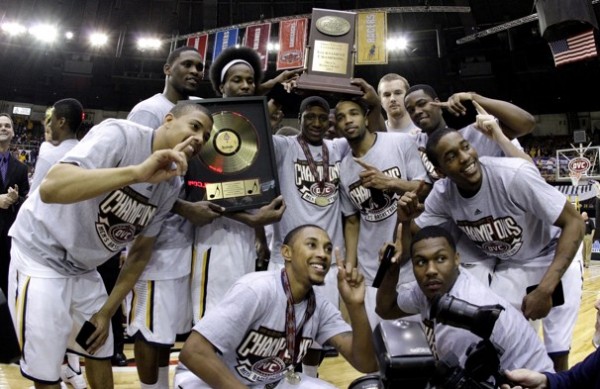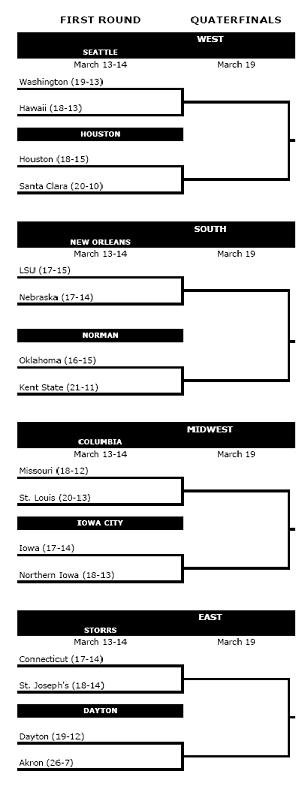Tracking The Four: Regular Season Recap, Postseason Prospects
Posted by EJacoby on March 7th, 2012Evan Jacoby is a regular contributor for RTC. You can find him @evanjacoby on Twitter. TT4 will cover four selected teams of interest — Syracuse, Indiana, Murray State, and UNLV — by tracking their ups, downs, and exciting developments throughout the course of the season.
It was a wild ride for our four teams this year, yet the most important games are just beginning. All four teams are locks for the NCAA Tournament and will have high hopes to do some damage in the postseason. But before Selection Sunday comes, let’s take a look at how each team finished its regular season and what its prospects are for postseason play. Murray State, of course, finished its regular season early and already completed its postseason tournament as part of one of the mid-major leagues that began Championship Week last weekend. The Racers are OVC champions and we will preview their NCAA Tournament outlook while looking at the other three teams’ conference tourney prospects.
Murray State Racers
- Finished STRONG Because… – The Racers are on fire since losing their only game of the season and continue to look better and better. They finished off the season with impressive wins at Tennessee State and Tennessee Tech. That earned them a double-bye in the OVC Tournament where they only had to win one game before the finals, and oddly enough the two teams that Murray matched up with in the conference bracket were the two teams with which it had ended the season. Victories over Tennessee Tech (a blowout) and Tennessee State (a nailbiter) proved that this team can win in a variety of ways and that it is peaking heading into postseason play.
- Resume Review – Murray State finishes tied with the nation’s best overall record at 30-1, which could be the outright best record if neither Syracuse nor Kentucky wins its conference tournaments. The Racers finished 17-1 against OVC competition with an RPI of #24. They went 3-0 against the RPI top-50, with good wins at Memphis and against Southern Miss on a neutral floor. Their only loss was a ‘bad’ one, at home against Tennessee State’s #117 RPI. Murray State’s Pomeroy/Sagarin/BPI/LRMC rankings are as follows: #45/#40/#33/#29. Very solid all-around.
- Seed Projection – Since all of its games are now completed, we can start projecting Murray State’s NCAA Tournament seed accurately. This team is looking like a #5 or #6 seed according to the consensus bracketologists around the country, though I believe it is closer to a #4 than it is a #6. A #5-seed seems about right, which could possibly mean they’d play in Nashville or Louisville for their first two rounds next week.
- Player Developments – Isaiah Canaan is the runaway OVC Player of the Year and will receive consideration for national All-America teams as the stellar guard continues to play at an elite level. He averaged 19.4 points, 3.2 rebounds, and 3.6 assists per gamein his final five contests and continues to shoot lights out from three. Ivan Aska has struggled down the stretch, failing to record double-digit scoring or rebounding games in any of his last five. Murray State will desperately need his contributions against the bigger opponent it is likely to draw in the first round.
- Notable Numbers – Murray State’s +10.5 adjusted scoring margin is very similar to other potential #5- or #6-seeds like Louisville, Vanderbilt, and St. Mary’s. The Racers finished the season with the sixth-best three-point shooting percentage in the country (40.6%) and allowed opponents to shoot just 29.5% from three, ranked 16th best. That’s a tremendous margin. This team also finished with a top-15 free throw rate, true shooting percentage, and steal percentage. The Racers want to send high pressure defensively to look for steals, get out in transition, and hit open threes. This helps hide the fact that they are such a small team inside.
- Preview & Predictions! – All that’s left for this team is the Big Dance. Therefore, it’s really impossible to predict success without seeing the bracket. However, I don’t think this team is going to be upset in its first game unless it gets a really rough matchup. Assuming a #5 seed, Murray should draw one of the middling bubble teams from a power conference, and it just has to hope it gets someone like Tennessee or Northwestern rather than someone like UConn (sporting great size). From there, we need to see the matchups before declaring whether this team could make the Sweet Sixteen.
Syracuse Orange
- Finished STRONG Because… – The Orange finished on a 10-game winning streak and have locked up an NCAA Tournament #1 seed regardless of what happens in the Big East Tournament. The Orange will receive a double-bye and don’t need to play until Thursday, where they will already be in the quarterfinals. Their final five wins were all by 10 points or less, so the scoring margins have not been dominant but the experience of closing out close games should be just as important for Syracuse going forward.












































